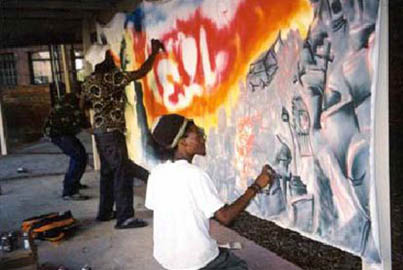Building AIDS awareness through the arts
Building AIDS awareness through the arts McGill University
User Tools (skip):
Building AIDS awareness through the arts

YAHAnet screen capture of the MSE Graffiti Crew in Cape Town, South Africa
On December 1, the 20th edition of World AIDS Day, those fighting to raise awareness of the disease will have a new tool at their disposal, one aimed at a demographic that has often proven difficult to engage.
"AIDS education is about engaging teens in creating their own messages and getting them involved in the dialogue," says Claudia Mitchell of the Faculty of Education. She is one of the principal minds behind an arts-based educational tool aimed at teenagers, called YAHAnet (Youth, Arts, HIV & AIDS network).
YAHAnet will enable hundreds of youth groups from around the world to upload and showcase their drama, photography, video, graffiti, hip-hop and new media art projects in helping to "get the word out" on HIV/AIDS. The site was conceived as a means of tapping into the creativity of young people and letting their voices be heard as cultural producers of HIV/AIDS messaging.
The project was spearheaded by Mitchell, her colleagues Bronwen Low and Michael Hoechsmann of the Faculty of Education, and UNESCO's Culture and HIV division. Getting it up and running has been no small task either. The team got much-needed help from about a dozen enthusiastic McGill student interns, partners from GAAP (Gendering Adolescence and AIDS Prevention), and the Center for Visual Methodologies for Social Change at the University of KwaZulu-Natal, who have all been working tirelessly with Mitchell for the past several months to get the project up and running.
Mitchell can barely hide her excitement, long convinced of the importance of creativity as a means of encouraging dialogue around HIV/AIDS. "There's research that shows that one-size-fits-all messaging created by adults isn't working," she says. She explains that in this age of "AIDS fatigue," young people need to be given a more significant role in producing and disseminating locally relevant messages. Unless we look for new approaches that resonate with teens, HIV/AIDS education programs may be doomed. "[With teens], it's about reflection and discussion and having something concrete to show for it. It's not just about knowledge; it's about working through this."
The YAHAnet project was initiated a year and a half ago, when Mitchell's team assessed the emerging community of youth groups that work in the field for UNESCO. After studying over 300 organizations, it became clear that many were using arts-based projects as youth-focused HIV/AIDS education tools. These groups were looking for a forum that would facilitate communication, idea-sharing and problem-solving among groups that would help further their work.
When the site officially goes live on World AIDS Day, YAHAnet will be much more than a virtual art gallery. The site will house a searchable database of literature on why to use the arts for social change and in-depth "how to" guides on everything from graffiti to puppetry to radio documentaries. It will also act as a social networking tool for like-minded advocacy groups around the world, and will serve as an invaluable clearing house for up-to-date information on youth-related HIV/AIDS statistics and the latest health and behaviour research. Most of all, it will give teens a unique way to express themselves about the disease, adding valuable voices to an essential dialogue.

